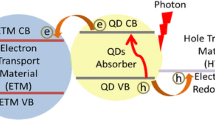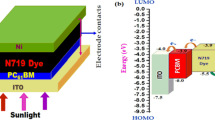Abstract
A simplified numerical model has been proposed to optimize the effect of pseudo-homogeneous and bulk electrolyte medium in dye-sensitized solar cells. Firstly, the equations of continuity and transport are derived for all charged species namely electrons, iodide ions (\({{{\text{I}}}^{ - }}\)) and tri-iodide ions (\({\text{I}}_{3}^{ - }\)). The cell model compiled of a pseudo-homogeneous medium is the grouping of three layers i.e., nanoporous TiO2 layer, sensitizer and redox mediator. On the other side is a bulk electrolyte medium in which only ion diffusion takes place. Recombinations at the working electrode and a voltage drop at the counter electrode are incorporated in the present model. Parametric studies were conducted to analyze the length of optimal bulk electrolyte layer and a set of simulations executed by changing the morphology in the range from 0.2 to 1.6 μm and gave the highest at 0.8 μm with current density of 31.7 mA cm–2. The higher current density ensures a good efficiency. The length of the bulk electrolyte layer is reduced as far as possible, and the length of the active layer mediated in relation to the recombination rates and diffusion control current with the choice of the redox mediator.






Similar content being viewed by others
REFERENCES
Grätzel, M., Optimizing photon harvesting and carrier collection in mesoscopic solar energy conversion systems, Presentation at MRS Fall Meeting, Boston, MA, 2009.
Lee, C.P., Li, C.T., and Ho, K.C., Use of organic materials in dye-sensitized solar cells, Mater. Today, 2017, vol. 20, no. 5, pp. 267–283.
Heo, J.H., Im, S.H., Noh, J.H., Mandal, T.N., Lim, C.S., Chang, J.A., Lee, Y.H., Kim, H.J., Sarkar, A., Nazeeruddin, M.K., and Grätzel, M., Efficient inorganic-organic hybrid heterojunction solar cells containing perovskite compound and polymeric hole conductors, Nat. Photon., 2013, vol. 7, no. 6, pp. 486.
Sodergren, S., Hagfeldt, A., Olsson, J., and Lindquist, S.E., Theoretical models for the action spectrum and the current–voltage characteristics of microporous semiconductor films in photoelectrochemical cells, J. Phys. Chem. A, 1944, vol. 98, no. 21, pp. 5552–5556.
Papageorgiou, N., Liska, P., Kay, A., and Grätzel, M., Mediator transport in multilayer nanocrystalline photoelectrochemical cell configurations, J. Electrochem. Soc., 1999, vol. 146, no. 3, pp. 898–907.
Ferber, J., Stangl, R., and Luther, J., An electrical model of the dye-sensitized solar cell, Sol. Energy Mater. Sol. Cells, 1998, vol. 53, nos. 1–2, pp. 29–54.
Ferber, J. and Luther, J., Modeling of photovoltage and photocurrent in dye-sensitized titanium dioxide solar cells, J. Phys. Chem. B, 2001, vol. 105, no. 21, pp. 4895–4903.
Usami, A. and Ozaki, H., Computer simulations of charge transport in dye-sensitized nanocrystalline photovoltaic cells, J. Phys. Chem. B, 2001, vol. 105, no. 20, pp. 4577–4583.
Oda, T., Tanaka, S., and Hayase, S., Differences in characteristics of dye-sensitized solar cells containing acetonitrile and ionic liquid-based electrolytes studied using a novel model, Sol. Energy Mater. Sol. Cells, 2006, vol. 90, no. 16, pp. 2696–2709.
Penny, M., Farrell, T., and Please, C., A mathematical model for interfacial charge transfer at the semiconductor–dye–electrolyte interface of a dye-sensitised solar cell, Sol. Energy Mater. Sol. Cells, 2008, vol. 92, no. 1, pp. 11–23.
Penny, M., Farrell, T., and Will, G., A mathematical model for the anodic half cell of a dye-sensitised solar cell, Sol. Energy Mater. Sol. Cells, 2008, vol. 92, no. 1, pp. 24–37.
Villanueva, J., Anta, J.A., Guillén, E., and Oskam, G., Numerical simulation of the current-voltage curve in dye-sensitized solar cells, J. Phys. Chem. C, 2009, vol. 113, no. 45, pp. 19722–19731.
Villanueva-Cab, J., Oskam, G., and Anta, J.A., A simple numerical model for the charge transport and recombination properties of dye-sensitized solar cells: a comparison of transport-limited and transfer-limited recombination, Sol. Energy Mater. Sol. Cells, 2010, vol. 94, no. 1, pp. 45–50.
Barnes, P.R., Anderson, A.Y., Durrant, J.R., and O’Regan, B.C., Simulation and measurement of complete dye sensitised solar cells: including the influence of trapping, electrolyte, oxidised dyes and light intensity on steady state and transient device behaviour, Phys. Chem. Chem. Phys., 2011, vol. 13, no. 13, pp. 5798–5816.
Nepal, J., Sadegh Mottaghian, S., Biesecker, M., and Farrokh Baroughi, M., Modeling of trap assisted interfacial charge transfer in dye sensitized solar cells, Appl. Phys. Lett., 2013, vol. 102, no. 20, p. 203503.
Belarbi, M., Benyoucef, B., Benyoucef, A., Benouaz, T., and Goumri-Said, S., Enhanced electrical model for dye-sensitized solar cell characterization, Sol. Energy, 2015, vol. 122, pp. 700–711.
Gong, J., Sumathy, K., Zhou, Z., and Qiao, Q., Modeling of interfacial and bulk charge transfer in dye-sensitized solar cells, Cogent Eng., 2017, vol. 4, no. 1, p. 1287231.
Anta, J.A., Casanueva, F., and Oskam, G., A numerical model for charge transport and recombination in dye-sensitized solar cells, J. Phys. Chem. B, 2006, vol. 110, pp. 5372–5378.
Maldon, B., Thamwattana, N., and Edwards, M., Exploring nonlinear diffusion equations for modelling dye-sensitized solar cells, 2020, Entropy, vol. 22, p. 248.
Andrade, L., Sousa, J., Ribeiro, H.A., and Mendes, A., Phenomenological modeling of dye-sensitized solar cells under transient conditions, Sol. Energy, 2020, vol. 85, pp. 781–793.
Gacemi, Y., Cheknane, A., and Hilal, H.S., Simulation and modelling of charge transport in dye-sensitized solar cells based on carbon nano-tube electrodes, Phys. Scripta, 2013, vol. 87, pp. 035703–035714.
Maldon, B. and Thamwattana, N., An analytical solution for charge carrier densities in dye-sensitized solar cells, J. Photochem. Photobiol., 2019, vol. 370, pp. 41–60.
Sahu, S., Patel, M., Verma, A.K., and Tiwari, S., Analytical study of current density-voltage relation in dye-sensitized solar cells using equivalent circuit model, in 2017 International Conference on Energy, Communication, Data Analytics and Soft Computing (ICECDS), IEEE, 2017, pp. 1489–1493.
Joseph, I., Louis, H., Unimuke, T.O., Etim, I.S., Orosun, M.M., and Odey, J., An overview of the operational principles, light harvesting and trapping technologies and recent advances of the dye-sensitized solar cells, Appl. Sol. Energy, 2020, vol. 56, no. 5, pp. 334–363.
Sahu, S., Electrical modeling of dye-sensitized solar cells for improving the overall photoelectric conversion efficiency, J. Ravishankar Univ., 2019, vol. 32, no. 1, pp. 84–89.
Rudra, S., Seo, H.W., Sarker, S., and Kim, D.M., Simulation and electrochemical impedance spectroscopy of dye-sensitized solar cells, J. Ind. Eng. Chem., 2021, vol. 97, pp. 574–583.
Yeoh, M.E., Chan, K.Y., and Knipp, D., Simplified electrical modeling for dye sensitized solar cells: Influences of the blocking layer and chenodeoxycholic acid additive, Solid-State Electron., 2021, vol. 180, p. 107983.
Manaa, M.B., Issaoui, N., Bouaziz, N., and Lamine, A.B., Combined statistical physics models and DFT theory to study the adsorption process of paprika dye on TiO2 for dye-sensitized solar cells, J. Mater. Res. Technol., 2020, vol. 9, no. 2, pp. 1175–1188.
Chalkias, D.A., Loizos, D.D., and Papanicolaou, G.C., Evaluation and prediction of dye-sensitized solar cells stability under different accelerated ageing conditions, Sol. Energy, vol. 207, pp. 841–850, 2020.
Zolghadr, A.R., Estakhr, O., Dokoohaki, M.H., and Salari, H., Comparison between Bi2WO6 and TiO2 photoanodes in dye-sensitized solar cells: experimental and computational studies, Ind. Eng. Chem. Res., 2021, vol. 60, no. 33, pp. 12292–12306.
Hagfeldt, A. and Graetzel, M., Light-induced redox reactions in nanocrystalline systems, Chem. Rev., 1995, vol. 95, no. 1, pp. 49–68.
Boschloo, G. and Hagfeldt, A., Characteristics of the iodide/tri-iodide redox mediator in dye-sensitized solar cells, Acc. Chem. Res., 2009, vol. 42, no. 11, pp. 1819–1826.
Papageorgiou, N., Grätzel, M., and Infelta, P.P., On the relevance of mass transport in thin layer nanocrystalline photoelectrochemical solar cells, Sol. Energy Mater. Sol. Cells, 1996, vol. 44, no. 4, pp. 405–438.
ACKNOWLEDGMENTS
The authors would like to thank Photonics Research Laboratory, School of Studies in Electronics and Photonics, Pt. Ravishankar Shukla University, Raipur (C.G.), India for supporting this work.
Author information
Authors and Affiliations
Corresponding author
Ethics declarations
The authors declare that they have no conflicts of interest.
About this article
Cite this article
Swati Sahu, Sanjay Tiwari Analysis of Pseudo-Homogeneous and Bulk Charge Transfer in Dye-Sensitized Solar Cells. Appl. Sol. Energy 57, 355–362 (2021). https://doi.org/10.3103/S0003701X21050145
Received:
Revised:
Accepted:
Published:
Issue Date:
DOI: https://doi.org/10.3103/S0003701X21050145




